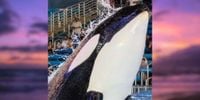SeaWorld San Antonio announced on June 19, 2025, the heartbreaking death of Kamea, its youngest orca whale, who passed away at just 11 years old after contracting an unspecified illness. Despite receiving "around-the-clock tireless" care from dedicated animal care and veterinary teams, Kamea succumbed to her condition, leaving staff, visitors, and animal advocates deeply saddened.
Kamea was born at SeaWorld San Antonio and was the youngest member of her orca pod, which includes her 33-year-old mother Takara, 15-year-old sister Sakari, and two other males. While wild orcas can live between 50 and 90 years, orcas in captivity often survive only 20 to 30 years, a stark contrast that highlights the challenges of life in confinement.
In a poignant Facebook post, SeaWorld San Antonio reflected on Kamea's impact: "Kamea brought joy and inspiration to millions of guests over the years. Her playful spirit and unique personality touched the hearts of all who knew her. This is an incredibly difficult time for our SeaWorld family, especially those who worked closely with her. We are grateful for the support of our community as we remember and honor Kamea together." The park did not disclose the exact nature of her illness.
Former staff members took to social media to express their grief and share fond memories. One trainer recalled, "Kamea was such a unique and spirited animal. Working alongside her and her family was and always will be the highlight of my life. She taught everyone so much about her playful, sassy nature and she will always be remembered. My love goes out to the pod and the trainers who loved her dearly." Another former employee reminisced about watching Kamea grow, saying, "I have many happy memories of watching her grow and learn with her pod and trainers. Love and hugs, y’all." Visitors also shared their condolences, with one recalling a playful moment when Kamea mischievously splashed an employee during a show, highlighting her lively personality.
However, Kamea's death has also reignited criticism from animal rights organizations, particularly People for the Ethical Treatment of Animals (PETA), which condemned the conditions under which captive orcas live. PETA highlighted that Kamea is the 45th orca to die under SeaWorld's care since the parks' founding, underscoring a troubling pattern of early deaths among captive orcas.
In nature, orcas are highly intelligent, social creatures that live in tight-knit family pods for life, traveling vast distances, hunting cooperatively, and communicating through unique dialects passed down through generations. Kamea was denied this natural life, spending her entire existence in a concrete tank at SeaWorld San Antonio.
PETA President Ingrid Newkirk issued a statement demanding that SeaWorld cremate Kamea and spread her ashes in the ocean, her rightful home. "In nature, Kamea could have lived to 80 years old, surrounded by her friends and family in the vast, open ocean, but SeaWorld condemned her to a miserable life and early death in a concrete prison cell," Newkirk said. She also called on SeaWorld to release the remaining orcas to seaside sanctuaries, emphasizing the urgency of ending the captivity of these majestic animals before more lives are lost.
Kamea’s lineage tells a poignant story of generational suffering. Her grandmother, Kasatka, was captured from the wild as a young calf and spent nearly four decades in cramped tanks at SeaWorld, where she was repeatedly bred and forced to perform. Kasatka died in 2017 at SeaWorld San Diego after battling a painful bacterial lung infection. Kamea’s mother, Takara, was born at SeaWorld and has never known life outside captivity. She remains imprisoned at the San Antonio facility following Kamea’s death. Kamea’s father, Kshamenk, was taken from the ocean in 1992 and is now the last orca held in a tank at Mundo Marino in Argentina, where he reportedly floats listlessly or swims in endless circles.
SeaWorld has faced mounting pressure over the years due to these conditions. In 2016, the company announced it would end its orca breeding program, stating that the orcas then living in its parks would be the last generation bred and would remain at SeaWorld for life. The company also agreed to stop trainers standing on dolphins’ faces and backs in circus-style shows, a move influenced by campaigns led by PETA and other advocacy groups.
Despite these changes, 17 orcas remain in SeaWorld parks, continuing to live in captivity under conditions that many argue do not meet their complex physical and psychological needs. Additionally, other dolphins and whales are still used for breeding, perpetuating a cycle of confinement and exploitation.
The death of Kamea serves as a stark reminder of the ongoing ethical and welfare concerns surrounding captive marine mammals. It has galvanized calls from animal rights groups and concerned members of the public urging SeaWorld to take more substantial steps, including relocating the remaining orcas to seaside sanctuaries where they can experience a semblance of natural life.
SeaWorld San Antonio has not publicly responded to PETA’s demands regarding Kamea’s remains or the release of the surviving orcas. Meanwhile, the community continues to mourn the loss of a beloved orca whose playful spirit touched countless lives but whose life was tragically cut short.
Kamea’s story is emblematic of a broader debate about the ethics of marine mammal captivity, raising questions about the balance between entertainment, education, and animal welfare. As the conversation evolves, many hope that Kamea’s legacy will inspire meaningful change, ensuring that future generations of orcas can live free and fulfilled lives in the wild.

